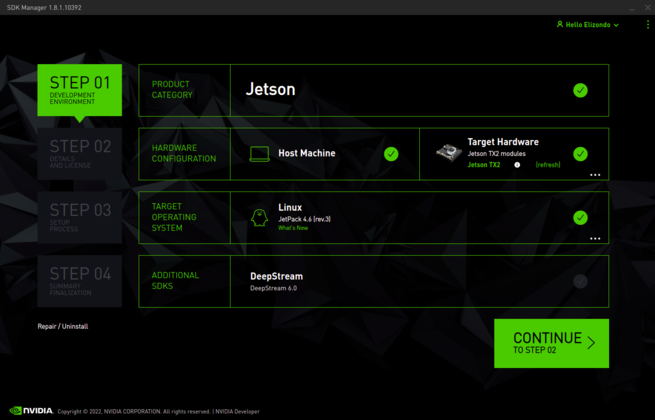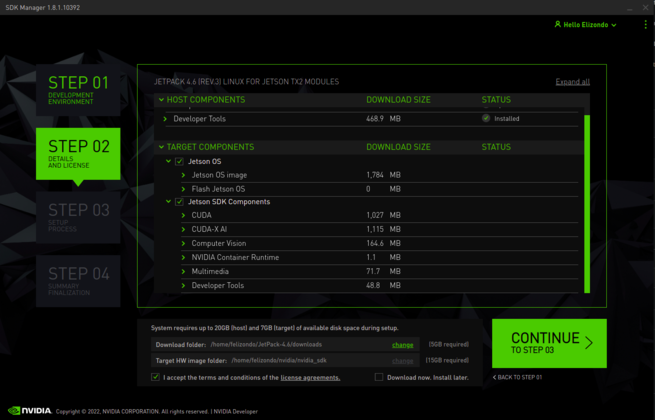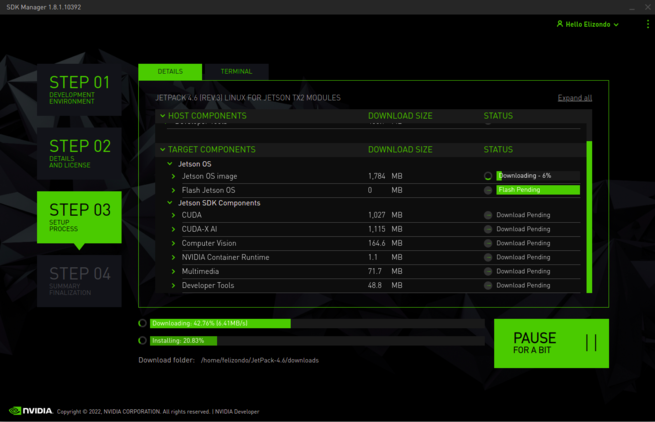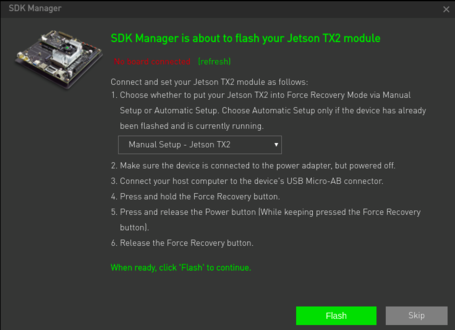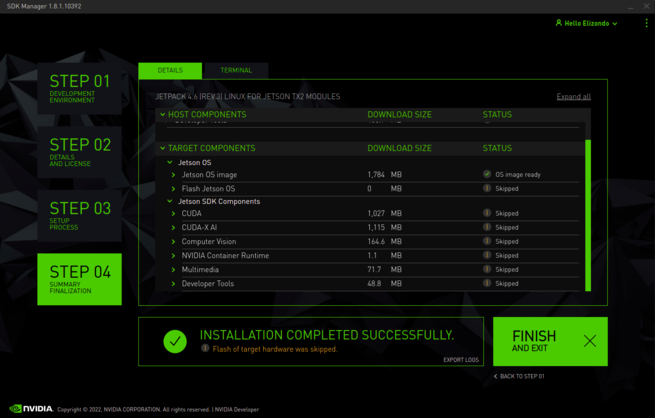Difference between revisions of "Installing JetPack 4.6 - NVIDIA SDK Manager"
(Created page with "<seo title="Installing Jetpack 4.6 | NVIDIA SDK Manager | RidgeRun Developer" titlemode="replace" keywords="GStreamer, Linux SDK, Linux BSP, Embedded Linux, Device Drivers, N...") |
m |
||
| (19 intermediate revisions by one other user not shown) | |||
| Line 1: | Line 1: | ||
<seo title="Installing Jetpack 4.6 | NVIDIA SDK Manager | RidgeRun Developer" titlemode="replace" keywords="GStreamer, Linux SDK, Linux BSP, Embedded Linux, Device Drivers, NVIDIA, Jetson, Jetson TX1, Jetson TX2, Xavier, NVIDIA Jetson Xavier, NVIDIA Jetson Xavier NX, Jetson Xavier, Jetson Xavier NX, Jetson Nano, Embedded Linux driver development, Linux Software development, Embedded Linux SDK, Embedded Linux Application development, GStreamer Multimedia Framework, JetPack 4.6, JetPack, NVIDIA SDK Manager, SDK Manager, JetPack for Jetson AGX Xaver, NVIDIA SDK, NVIDIA Software Development Kit" description="This wiki document contains helpful instructions and diagrams for installing Jetpack 4.6. Learn how to properly install Jetpack 4.6 with the help of RidgeRun Developer today."></seo> | <seo title="Installing Jetpack 4.6 | NVIDIA SDK Manager | RidgeRun Developer" titlemode="replace" keywords="GStreamer, Linux SDK, Linux BSP, Embedded Linux, Device Drivers, NVIDIA, Jetson, Jetson TX1, Jetson TX2, Xavier, NVIDIA Jetson Xavier, NVIDIA Jetson Xavier NX, Jetson Xavier, Jetson Xavier NX, Jetson Nano, Embedded Linux driver development, Linux Software development, Embedded Linux SDK, Embedded Linux Application development, GStreamer Multimedia Framework, JetPack 4.6, JetPack, NVIDIA SDK Manager, SDK Manager, JetPack for Jetson AGX Xaver, NVIDIA SDK, NVIDIA Software Development Kit" description="This wiki document contains helpful instructions and diagrams for installing Jetpack 4.6. Learn how to properly install Jetpack 4.6 with the help of RidgeRun Developer today."></seo> | ||
| + | |||
| + | <table> | ||
| + | <tr> | ||
| + | <td><div class="clear; float:right">__TOC__</div></td> | ||
| + | <td> | ||
| + | {{NVIDIA Preferred Partner logo}} | ||
| + | <td> | ||
| + | <center> | ||
| + | {{ContactUs Button}} | ||
| + | </center> | ||
| + | </tr> | ||
| + | </table> | ||
==Overview== | ==Overview== | ||
| Line 9: | Line 21: | ||
==Requirements for Jetson== | ==Requirements for Jetson== | ||
* Ubuntu Linux 16.04 or 18.04 x64 host-machine with working Internet connection. | * Ubuntu Linux 16.04 or 18.04 x64 host-machine with working Internet connection. | ||
| − | * Memory: 8GB | + | * Memory: 8GB. |
* A minimum of 25GB free disk space on the system volume is needed for each full (host and target) deployed SDK version. | * A minimum of 25GB free disk space on the system volume is needed for each full (host and target) deployed SDK version. | ||
* X11 must be enabled on the host. | * X11 must be enabled on the host. | ||
| Line 15: | Line 27: | ||
==Install NVIDIA SDK Manager== | ==Install NVIDIA SDK Manager== | ||
1. Download [https://developer.nvidia.com/nvidia-sdk-manager NVIDIA SDK Manager]. <br> | 1. Download [https://developer.nvidia.com/nvidia-sdk-manager NVIDIA SDK Manager]. <br> | ||
| − | 2. Install debian package | + | 2. Install debian package. |
sudo apt install ./sdkmanager-[version].[build#].deb | sudo apt install ./sdkmanager-[version].[build#].deb | ||
| Line 28: | Line 40: | ||
For example to build JetPack for Jetson TX2: | For example to build JetPack for Jetson TX2: | ||
* Jetson product. | * Jetson product. | ||
| − | * Host Machine and Target Hardware: Jetson TX2 | + | * Host Machine and Target Hardware: Jetson TX2. |
| − | * Linux Jetpack 4.6 | + | * Linux Jetpack 4.6. |
* If you like you can also choose to install the NVIDIA DeepStream SDK using the SDK Manager. For this example, that option is not required. | * If you like you can also choose to install the NVIDIA DeepStream SDK using the SDK Manager. For this example, that option is not required. | ||
| − | [[ | + | <br> |
| − | <div style="text-align: center;">'''Figure 1'''. Development Environment </div> | + | |
| + | [[File:JP4-6 TX2 SDK Manager.png|center|655px|Development Environment]] | ||
| + | <div style="text-align: center;">'''Figure 1'''. Development Environment </div> | ||
===Step 2: Review Components and Accept Licenses=== | ===Step 2: Review Components and Accept Licenses=== | ||
* Review host and target components that will be installed and accept the terms and conditions of the license agreements. | * Review host and target components that will be installed and accept the terms and conditions of the license agreements. | ||
| − | * You can also select your desired download and target HW image folders | + | * You can also select your desired download and target HW image folders. For future downloads, you can reuse the same download directory to leverage the previously installed components. |
| − | * Press continue | + | * Press continue. |
| − | [[ | + | [[File:JP4.6 Review Components.png |center|655px|Review Components]] |
| − | <div style="text-align: center;">'''Figure 2'''. Review Components </div> | + | <div style="text-align: center;">'''Figure 2'''. Review Components </div> |
===Step 3: Installation=== | ===Step 3: Installation=== | ||
| Line 49: | Line 63: | ||
<br> | <br> | ||
<br> | <br> | ||
| − | [[ | + | [[File:JP4.6 Instalaltion.png|center|655px|Installation]] |
<div style="text-align: center;">'''Figure 3'''. Installation </div> | <div style="text-align: center;">'''Figure 3'''. Installation </div> | ||
A window will appear when the image is ready to be flashed into the target board: | A window will appear when the image is ready to be flashed into the target board: | ||
| + | * If the board was not connected yet, as shown in the following image, this is the time to plug it into the host computer. The SDK Manager will automatically recognize the device, or you can click on the "refresh" option if that wasn't the case. | ||
* Select manual setup and put the board into recovery mode. | * Select manual setup and put the board into recovery mode. | ||
* When the flash is finished, connect the keyboard, mouse, and monitor to the target board in order to set the initial configuration (language, country, username, and password) for the Jetson system. | * When the flash is finished, connect the keyboard, mouse, and monitor to the target board in order to set the initial configuration (language, country, username, and password) for the Jetson system. | ||
<br> | <br> | ||
| − | [[ | + | [[File:JP4.6 Flash.png|center|455px|Flash]] |
<div style="text-align: center;">'''Figure 4'''. Flash </div> | <div style="text-align: center;">'''Figure 4'''. Flash </div> | ||
| Line 62: | Line 77: | ||
<br> | <br> | ||
<br> | <br> | ||
| − | [[ | + | [[File:JP4-6 TX2 Installation.png|center|455px|Components Installation]] |
| − | <div style="text-align: center;">'''Figure 5'''. Components Installation </div> | + | <div style="text-align: center;">'''Figure 5'''. Components Installation </div> |
===Step 4: Finalize Setup=== | ===Step 4: Finalize Setup=== | ||
| − | + | As you can see in the previous figures, the SDK Manager also gives the option to skip the flashing process. This is useful for development purposes, in case you need a manual setup. If you skip the flashing process, the SDK Manager will show you a summary of the installed components and then you can press "Finish and Exit". Otherwise, the SDK Manager will indicate a final message about the complete process result. | |
| + | |||
<br> | <br> | ||
<br> | <br> | ||
| − | [[ | + | [[File:JP4.6 Flash Skipped.png|center|655px|Finalize Setup]] |
| − | <div style="text-align: center;">'''Figure 6'''. Finalize Setup </div> | + | <div style="text-align: center;">'''Figure 6'''. Finalize Setup </div> |
==Links== | ==Links== | ||
Latest revision as of 00:11, 18 August 2022
|
|
Overview
JetPack 4.6 should be installed using The NVIDIA Software Development Kit (SDK) Manager which is a tool that bundles developer software and provides an end-to-end development environment setup solution for NVIDIA SDKs.
This wiki page is a summary of how to install JetPack via the NVIDIA SDK Manager. If you have required additional details feel free to review the following resources:
Requirements for Jetson
- Ubuntu Linux 16.04 or 18.04 x64 host-machine with working Internet connection.
- Memory: 8GB.
- A minimum of 25GB free disk space on the system volume is needed for each full (host and target) deployed SDK version.
- X11 must be enabled on the host.
Install NVIDIA SDK Manager
1. Download NVIDIA SDK Manager.
2. Install debian package.
sudo apt install ./sdkmanager-[version].[build#].deb
Install JetPack 4.6
Launch SDK Manager and enter the credentials for your account type, and click Login.
sdkmanager
Step 1: Setup the Development Environment
Select product category, hardware configuration, and target operating system, then press continue.
For example to build JetPack for Jetson TX2:
- Jetson product.
- Host Machine and Target Hardware: Jetson TX2.
- Linux Jetpack 4.6.
- If you like you can also choose to install the NVIDIA DeepStream SDK using the SDK Manager. For this example, that option is not required.
Step 2: Review Components and Accept Licenses
- Review host and target components that will be installed and accept the terms and conditions of the license agreements.
- You can also select your desired download and target HW image folders. For future downloads, you can reuse the same download directory to leverage the previously installed components.
- Press continue.
Step 3: Installation
A security window will appear, so enter your password to proceed. Then the download and installing process will begin.
A window will appear when the image is ready to be flashed into the target board:
- If the board was not connected yet, as shown in the following image, this is the time to plug it into the host computer. The SDK Manager will automatically recognize the device, or you can click on the "refresh" option if that wasn't the case.
- Select manual setup and put the board into recovery mode.
- When the flash is finished, connect the keyboard, mouse, and monitor to the target board in order to set the initial configuration (language, country, username, and password) for the Jetson system.
A new window will appear asking for the Jetson's username/password in order to install components. You can skip this if you just need a basic setup.
Step 4: Finalize Setup
As you can see in the previous figures, the SDK Manager also gives the option to skip the flashing process. This is useful for development purposes, in case you need a manual setup. If you skip the flashing process, the SDK Manager will show you a summary of the installed components and then you can press "Finish and Exit". Otherwise, the SDK Manager will indicate a final message about the complete process result.
Links
|
RidgeRun Resources | |||||||||||||||||||||||||||||||||||||||||||||||||||||||
| |||||||||||||||||||||||||||||||||||||||||||||||||||||||
|
|||||||||||||||||||||||||||||||||||||||||||||||||||||||
| Visit our Main Website for the RidgeRun Products and Online Store. RidgeRun Engineering informations are available in RidgeRun Professional Services, RidgeRun Subscription Model and Client Engagement Process wiki pages. Please email to support@ridgerun.com for technical questions and contactus@ridgerun.com for other queries. Contact details for sponsoring the RidgeRun GStreamer projects are available in Sponsor Projects page. |  
|

